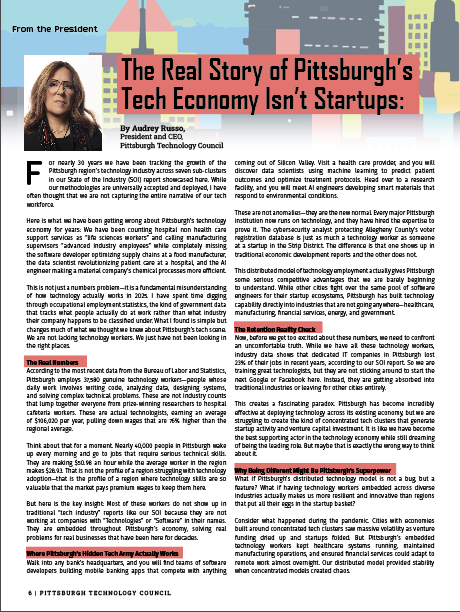The Real Story of Pittsburgh’s Tech Economy Isn’t Startups: It’s Embedded Talent Driving Transformation
by Audrey Russo, Pittsburgh Technology Council
 For nearly 30 years we have been tracking the growth of the Pittsburgh region’s technology industry across seven sub-clusters in our State of the Industry (SOI) report showcased here. While our methodologies are universally accepted and deployed, I have often thought that we are not capturing the entire narrative of our tech workforce.
For nearly 30 years we have been tracking the growth of the Pittsburgh region’s technology industry across seven sub-clusters in our State of the Industry (SOI) report showcased here. While our methodologies are universally accepted and deployed, I have often thought that we are not capturing the entire narrative of our tech workforce.
Here is what we have been getting wrong about Pittsburgh’s technology economy for years: We have been counting hospital non health care support services as “life sciences workers” and calling manufacturing supervisors “advanced industry employees” while completely missing the software developer optimizing supply chains at a food manufacturer, the data scientist revolutionizing patient care at a hospital, and the AI engineer making a material company’s chemical processes more efficient.
This is not just a numbers problem—it is a fundamental misunderstanding of how technology actually works in 2025. I have spent time digging through occupational employment statistics, the kind of government data that tracks what people actually do at work rather than what industry their company happens to be classified under. What I found is simple but changes much of what we thought we knew about Pittsburgh’s tech scene. We are not lacking technology workers. We just have not been looking in the right places.
 The Real Numbers
The Real Numbers
According to the most recent data from the Bureau of Labor and Statistics, Pittsburgh employs 37,580 genuine technology workers—people whose daily work involves writing code, analyzing data, designing systems, and solving complex technical problems. These are not industry counts that lump together everyone from prize-winning researchers to hospital cafeteria workers. These are actual technologists, earning an average of $106,020 per year, pulling down wages that are 76% higher than the regional average.
Think about that for a moment. Nearly 40,000 people in Pittsburgh wake up every morning and go to jobs that require serious technical skills. They are making $50.98 an hour while the average worker in the region makes $28.93. That is not the profile of a region struggling with technology adoption—that is the profile of a region where technology skills are so valuable that the market pays premium wages to keep them here.
But here is the key insight: Most of these workers do not show up in traditional “tech industry” reports like our SOI because they are not working at companies with “Technologies” or “Software” in their names. They are embedded throughout Pittsburgh’s economy, solving real problems for real businesses that have been here for decades.
Where Pittsburgh’s Hidden Tech Army Actually Works
Walk into any bank’s headquarters, and you will find teams of software developers building mobile banking apps that compete with anything coming out of Silicon Valley. Visit a health care provider, and you will discover data scientists using machine learning to predict patient outcomes and optimize treatment protocols. Head over to a research facility, and you will meet AI engineers developing smart materials that respond to environmental conditions.
These are not anomalies—they are the new normal. Every major Pittsburgh institution now runs on technology, and they have hired the expertise to prove it. The cybersecurity analyst protecting Allegheny County’s voter registration database is just as much a technology worker as someone at a startup in the Strip District. The difference is that one shows up in traditional economic development reports and the other does not.
This distributed model of technology employment actually gives Pittsburgh some serious competitive advantages that we are barely beginning to understand. While other cities fight over the same pool of software engineers for their startup ecosystems, Pittsburgh has built technology capability directly into industries that are not going anywhere—healthcare, manufacturing, financial services, energy, and government.
The Retention Reality Check
Now, before we get too excited about these numbers, we need to confront an uncomfortable truth. While we have all these technology workers, industry data shows that dedicated IT companies in Pittsburgh lost 23% of their jobs in recent years, according to our SOI report. So we are training great technologists, but they are not sticking around to start the next Google or Facebook here. Instead, they are getting absorbed into traditional industries or leaving for other cities entirely.
This creates a fascinating paradox. Pittsburgh has become incredibly effective at deploying technology across its existing economy, but we are struggling to create the kind of concentrated tech clusters that generate startup activity and venture capital investment. It is like we have become the best supporting actor in the technology economy while still dreaming of being the leading role. But maybe that is exactly the wrong way to think about it.
Why Being Different Might Be Pittsburgh’s Superpower
What if Pittsburgh’s distributed technology model is not a bug, but a feature? What if having technology workers embedded across diverse industries actually makes us more resilient and innovative than regions that put all their eggs in the startup basket?
Consider what happened during the pandemic. Cities with economies built around concentrated tech clusters saw massive volatility as venture funding dried up and startups folded. But Pittsburgh’s embedded technology workers kept healthcare systems running, maintained manufacturing operations, and ensured financial services could adapt to remote work almost overnight. Our distributed model provided stability when concentrated models created chaos.
More importantly, these embedded technologists understand both cutting-edge technology and real-world industry challenges in ways that pure-play tech workers often do not. The data scientist at a hospital knows more about healthcare workflow optimization than someone who has only worked at software companies. The AI engineer at a materials company understands materials science applications that would never occur to someone focused purely on consumer apps.
This combination of technical sophistication and domain expertise positions Pittsburgh to lead the next wave of technology innovation—the one where software finally transforms traditional industries instead of just creating new ways to order food or share photos.
And let us not forget Pittsburgh’s world-renowned robotics ecosystem. With Carnegie Mellon’s Robotics Institute leading global research and companies like Aurora, Argo AI alumni, and dozens of robotics startups calling Pittsburgh home, we have another layer of technical sophistication that most regions can only dream of. Our embedded technology workers are not just writing software—many are developing autonomous systems, industrial automation, and AI applications that bridge the physical and digital worlds. The deep tech revolution validates Pittsburgh’s distributed technology model. Rather than lacking concentration, Pittsburgh has something more valuable: technology workers who understand both cutting-edge capabilities and real-world applications across the industries that deep tech is transforming. Plus, Pittsburgh is growing a defense-related sector projected to generate $41 billion in spending over the 2020–2025 period, according to this year’s SOI report.
The Aspiration: From Hidden Asset to Innovation Engine
Here is what Pittsburgh could become if we start thinking strategically about our distributed technology advantage: the place where breakthrough innovations happen because technologists actually understand the industries they are transforming.
Imagine medical device breakthroughs emerging from collaborations between Highmark’s data scientists and the region’s manufacturing engineers. Picture autonomous systems developed by CMU robotics researchers working with embedded technologists at manufacturing companies to revolutionize production lines. Envision energy efficiency innovations developed by teams that include PPG’s materials scientists, robotics engineers, and software developers who understand industrial automation. Consider financial technology advances that come from technologists who have spent years understanding how regional banks actually operate, enhanced by AI and robotics capabilities that Pittsburgh pioneered.
This is not fantasy. it is the logical evolution of Pittsburgh’s existing strengths. We already have the technical talent. We already have world-class traditional industries. We already have research universities generating breakthrough discoveries. What we need is better connection between these assets and strategic support for the innovations that emerge when they collaborate.
The policy implications here are profound. Instead of chasing the latest startup accelerator trends or trying to recreate Silicon Valley, Pittsburgh should focus on maximizing the innovation potential of our embedded technology workforce. That means cross-industry collaboration programs, entrepreneur-in-residence positions for embedded technologists, and venture capital that understands deep tech applications rather than just consumer apps.
The Strategic Opportunity
Pittsburgh sits on the edge of a massive opportunity that most regions would kill for. We have premium-wage technology workers distributed across resilient industries, world-class research institutions generating breakthrough discoveries, a globally recognized robotics ecosystem that spans from Pitt and CMU’s research labs to commercial applications, and traditional industry expertise that spans manufacturing, healthcare, energy, and financial services. The question is whether we will recognize this combination as the foundation for sustainable innovation leadership or keep chasing someone else’s playbook.
The data tells us we are a region that needs to unleash the technology capability we already have. Our 37,580 technology workers are not just doing jobs, they are sitting at the intersection of technical possibility and industry reality, perfectly positioned to drive the innovations that matter most in an increasingly digital economy.
The choice is ours. We can keep measuring ourselves by metrics designed for different types of cities, or we can build strategies that leverage what makes Pittsburgh unique. We can keep looking for our technology workers in all the wrong places, or we can start connecting the dots between the technical talent that has been hiding in plain sight all along.
I have been a self-professed data nerd my entire life. The Tech Council will dig deeper into more workforce data to paint an even more complete picture of our region’s strengths and pinpoint the opportunities that can lead to growth.
Look for regular updates coming from me to not just guide the conversation, but hopefully also create new ones. The Tech Council is excited to provide you with this year’s SOI report as a baseline of our technology industry.